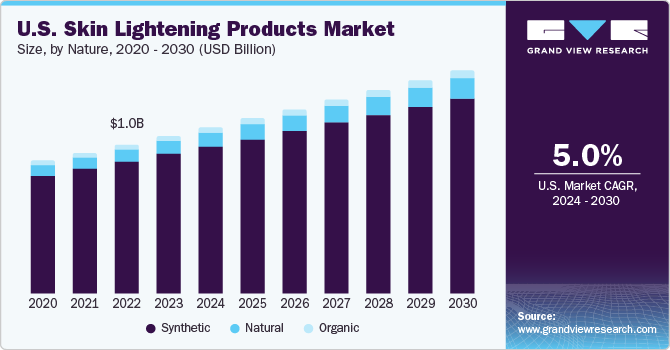U.S. Skin Lightening Products Market 2030: Millennials Drive Demand
The U.S. skin lightening products market was valued at USD 1.10 billion in 2023 and is expected to grow to USD 1.55 billion by 2030, expanding at a compound annual growth rate (CAGR) of 5.0% from 2024 to 2030.
The U.S. skin lightening products market was valued at USD 1.10 billion in 2023 and is expected to grow to USD 1.55 billion by 2030, expanding at a compound annual growth rate (CAGR) of 5.0% from 2024 to 2030. The growing consumer inclination toward targeted solutions for skin issues such as acne spots and age spots has significantly increased demand for skin lightening products.
In 2023, the U.S. accounted for nearly 10% of the global skin lightening products market. These products are widely used for their benefits, including reducing pigmentation, evening out skin tone, lightening discoloration, and diminishing blemishes. The rising influence of the internet and the growing number of social media users have transformed how companies market their products. Many key players in the U.S. are leveraging social media platforms as primary tools for product promotion and customer engagement. This digital shift, coupled with the increasing popularity of e-commerce, is expected to positively influence market growth in the coming years.
Consumer Preferences and Industry Response
There is an increasing preference among consumers for skin lightening products that use natural and organic ingredients. This trend is largely driven by awareness of potential health risks linked to traditional chemical ingredients such as mercury and hydroquinone, commonly found in older formulations. Cultural perceptions that associate fair skin with beauty and social standing also continue to influence consumer behavior.
Concerns over skin conditions like dark spots, hyperpigmentation, and uneven skin tone remain prominent, encouraging demand for gentler, nature-derived alternatives. This shift is creating opportunities for growth in products that incorporate naturally sourced ingredients such as aloe vera, argan oil, jojoba oil, and sea kelp.
Order a free sample PDF of the U.S. Skin Lightening Products Market Intelligence Study, published by Grand View Research.

Key Market Trends and Insights
- In 2023, synthetic-based products held a revenue share of over 88%, primarily because of their established effectiveness and widespread use in dermatology and cosmetic applications.
- The skin lightening creams segment accounted for 53.3% of the market share in 2023, favored for its ability to penetrate skin effectively. Companies continue to introduce creams with advanced formulations to boost performance and results.
Market Size and Forecast Summary
- 2022 Market Size (Global): USD 5,504.0 Million
- 2030 Projected Market Size (Global): USD 9,246.5 Million
- CAGR (2023–2030): 6.7%
Competitive Landscape
The U.S. skin lightening products market is characterized by intense competition. Major players are expanding their market reach through acquisitions of regional brands to strengthen service networks and customer trust.
Key market participants include:
- Whirlpool Corporation
- Samsung Electronics Co. Ltd.
- LG Electronics Inc.
- AB Electrolux
- GE Appliances
- BSH Hausgeräte GmbH
- IFB Industries Ltd.
- Panasonic Corporation
- Midea Group Co. Ltd.
- Hitachi, Ltd.
Explore Horizon Databook – The world's most expansive market intelligence platform developed by Grand View Research.
Conclusion
The U.S. skin lightening products market is experiencing steady growth, driven by consumer demand for effective solutions to common skin concerns and the rising appeal of both traditional and natural formulations. Digital marketing strategies, especially via social media and e-commerce platforms, are enhancing product visibility and customer outreach. Meanwhile, a growing preference for natural and organic ingredients is reshaping product development, offering new avenues for innovation. With the market expected to reach USD 1.55 billion by 2030, companies focusing on transparency, safety, and efficacy are likely to benefit the most in this evolving landscape.